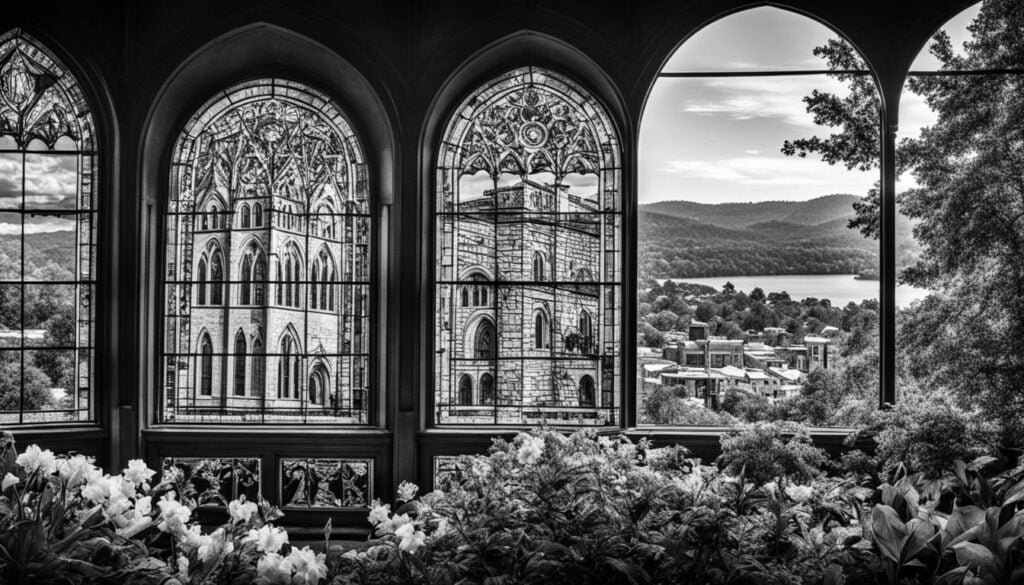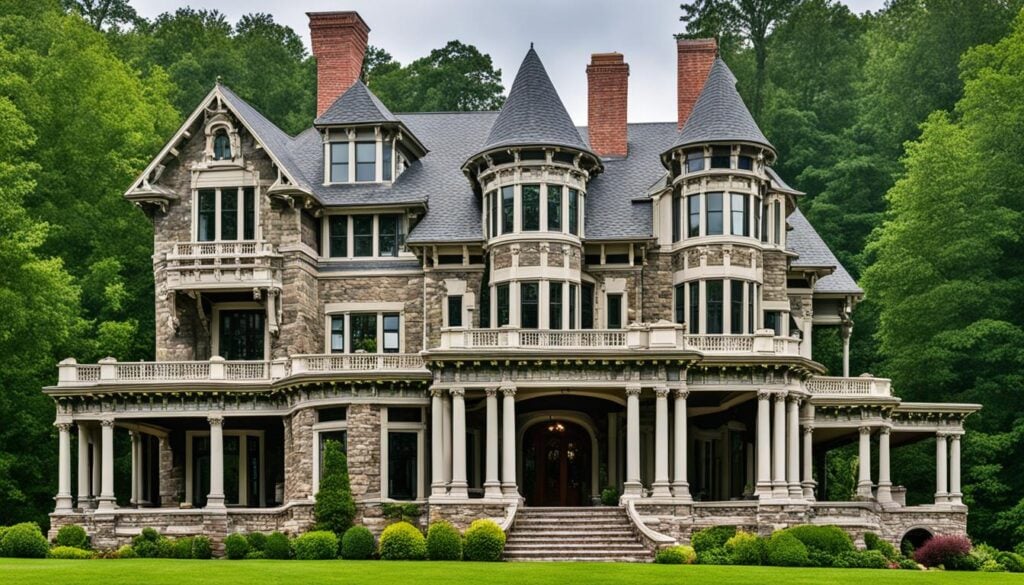Ever wondered about the stories behind Asheville’s historic landmarks? This city is full of sites that tell its rich cultural story. From grand estates to small memorials, each place offers a peek into the past. They show the beauty of architecture and the big events that shaped Asheville.
Get ready to explore Asheville’s must-see historical spots. These places tell the story of the region’s history in a fascinating way. Whether you love history or just find it interesting, Asheville has something for you.
Introduction to Asheville’s Rich History
Asheville’s history is a story of growth from a small mountain settlement to a bustling trade center by the late 18th century. You’ll see how this area was key in the American Revolution and the Civil War. It’s a journey through time.
In the late 19th and early 20th centuries, Asheville became famous for its beautiful landscapes and health retreats. This made it a top spot for people looking for wellness and a break. More visitors and residents came, boosting the city’s growth.
As Asheville grew, it became known for its diverse architecture and cultural heritage. This mix of historical styles and cultures has made Asheville a unique place to explore. It’s one of the top spots in Asheville, NC, to dive into history.
Why Explore Asheville Historical Sites
Exploring Asheville’s historical sites lets you see the city’s rich culture. Each place tells a unique story. This helps you understand the events and influences that shaped the city over time.
By diving into these stories, you learn about the city’s heritage. You’ll see how it fits into American history.
Understanding the Cultural Significance
The sites show how Asheville has changed over time. They let you connect with the city’s history. At each spot, you’ll hear stories of success, challenges, and strength.
These stories make you appreciate the city more. They help you feel a bond with people from the past.
Connecting with the Community
Joining local events and activities deepens your bond with Asheville’s culture. Talking with locals and historians makes your visit richer. It shows the city’s history is alive today.
Start exploring Asheville’s past. You’ll understand the community’s ongoing celebration of its heritage.
Must-See Historical Attractions in Asheville
Asheville is full of historical attractions that show its rich past. The Biltmore Estate and the Thomas Wolfe Memorial are two key sites. They show the city’s mix of history and stunning architecture. Visiting these places will deepen your understanding of Asheville’s history and culture.
Biltmore Estate: A Glimpse into the Gilded Age
The Biltmore Estate was built by George Washington Vanderbilt II in the late 1800s. It’s the biggest privately-owned home in the U.S. The estate is a prime example of Asheville’s historical architecture, showing the luxury of the Gilded Age.
Visitors can see the mansion’s fancy rooms, filled with beautiful furniture and art. The gardens, designed by Frederick Law Olmsted, add to the estate’s beauty.
Thomas Wolfe Memorial: Literary Heritage
The Thomas Wolfe Memorial is in the home where the famous author grew up. It celebrates his big impact on American literature. You can see exhibits and events that focus on Wolfe’s stories and Asheville’s beauty.
This site sheds light on Wolfe’s life and his big literary legacy. It’s a key spot for anyone who loves literature.
Asheville Historical Sites Celebrating the American History
Asheville is a city full of history, showing us key moments in American history. It’s known for its role in the Civil War and its mix of architectural styles. By visiting these sites, you can feel connected to the people and events that made this place special.
Sites from the Civil War Era
The Civil War left its mark on Asheville, and you can see it in many historic spots. You’ll find old military forts and hospitals that tell stories of life during the war. Some important places to visit are:
- Battle of Asheville: This battle showed how crucial this area was in the war.
- Fortify Asheville: This spot shows the military efforts during the war.
- Hospitals and Healing Sites: These places tell stories of healing and sacrifice.
Architectural Influences of the Past
Asheville’s buildings tell a story of its growth and history. You’ll see everything from Colonial to Art Deco styles. Some highlights include:
| Landmark | Architectural Style | Year Established |
|---|---|---|
| Grove Arcade | Neoclassical | 1929 |
| Old Courthouse | Romanesque Revival | 1906 |
| United States Post Office | Beaux-Arts | 1935 |
Exploring Asheville’s Past Through Guided Tours
Join an Asheville history tour to dive into the city’s captivating past. Knowledgeable guides share stories of key historical sites. You’ll learn about the people and events that made Asheville what it is today.
Asheville History Tours: What to Expect
Asheville history tours cater to different interests. Some focus on the Civil War era, others on the city’s architecture. You’ll get to know the region’s history in a way that makes it come alive.
The best historical sites in Asheville shine when explored on these tours. You’ll leave with a deeper appreciation for the city’s past.
Walking Tours of Historic Neighborhoods
Walking tours of neighborhoods like Montford and Downtown Asheville let you see the architecture up close. Each step tells a story, giving you a deeper look into the city’s history. It’s a personal way to experience Asheville’s past.
These tours bring the community to life. They turn history into an unforgettable journey through Asheville’s streets.

| Tour Type | Description | Duration | Price Range |
|---|---|---|---|
| Guided Bus Tour | Explore significant historical sites from the comfort of a bus. | 2 hours | $25 – $40 |
| Walking Tour | A leisurely stroll through historic neighborhoods with a focus on architecture. | 1.5 hours | $15 – $30 |
| Culinary History Tour | Discover Asheville’s food history while sampling local cuisine. | 3 hours | $50 – $75 |
| Civil War History Tour | Learn about local events and figures from the Civil War era. | 2.5 hours | $20 – $35 |
Enjoying the Best Historical Sites in Asheville
Asheville is full of vibrant historical sites that show off its rich past. The downtown area is a great place to dive into history with modern comforts. Here, you can see some of Asheville’s top historical spots, mixing culture and community in a fun way.
Downtown Asheville: A Historic Experience
Downtown Asheville is a key spot for exploring history, with places like the Asheville Art Museum and the Basilica of Saint Lawrence. You can walk through streets with art deco buildings and check out local shops and restaurants. All the while, you’ll feel the history around you. These spots in Asheville NC let you see the city’s architectural and cultural beauty.
Historic Places to Visit Near Asheville NC
But don’t just stick to downtown. Places like Pack Square and the River Arts District are worth a visit. They show how history and creativity come together here. Each spot gives you a peek into Asheville’s past and its lively community.
| Location | Type | Highlights |
|---|---|---|
| Asheville Art Museum | Museum | Contemporary and historical art collections |
| Basilica of Saint Lawrence | Religious Site | Stunning architecture and historical significance |
| Pack Square | Public Square | Cultural events and historic monuments |
| River Arts District | Arts Community | Studios and galleries showcasing local artists |
Famous Heritage Sites in Asheville
Asheville is known for its rich heritage sites that tell the story of its history and culture. The Black Mountain College and the Basilica of Saint Lawrence are key landmarks. They show the city’s lively past.
Significance of the Black Mountain College
The Black Mountain College started in 1933 as an experimental liberal arts school. It drew in top artists, musicians, and thinkers. They made big impacts on culture.
The college was known for its creative approach. It helped artists grow together. Even though it closed, its influence still shapes today’s art world. It’s a key spot for those interested in Asheville’s heritage.
The Basilica of Saint Lawrence: A Marvel of Architecture
The Basilica of Saint Lawrence is a gem of Asheville’s architecture, with its Spanish Mission style. It boasts the biggest handmade tiled dome in North America. Visitors are drawn to its detailed design and craftsmanship.
It’s more than a church; it’s a cultural icon. The Basilica shows off Asheville’s artistic and architectural skills. Walking inside, you’ll feel the grandeur and beauty. It’s a key part of Asheville’s heritage.

Asheville’s Architectural Wonders
Asheville is known for its diverse architectural styles, showing its rich history and artistic growth. The Art Deco style is a big part of this, with many iconic buildings. These landmarks let visitors see the city’s unique beauty.
Art Deco Influence in the City
The Art Deco style became popular in the 1920s and is seen in many Asheville buildings. The Asheville City Building and the Paramount Theatre are great examples. They have detailed designs, geometric shapes, and bright colors, adding elegance to the city.
Walking downtown, you’ll see these buildings that tell stories of innovation and creativity from the past.
Preservation of Historic Buildings
Keeping Asheville’s historic buildings is a big deal for locals and groups. These buildings connect us to the past in a real way. With the help of funds and community efforts, they are being restored and protected.
This way, future generations can also enjoy the beauty and cultural value of these buildings.
Asheville’s architecture shows the city’s artistic journey. Visiting these places will deepen your understanding of Asheville’s history. It will also make you appreciate its unique architectural style more.
| Building Name | Style | Year Completed | Location |
|---|---|---|---|
| Asheville City Building | Art Deco | 1928 | Asheville, NC |
| Paramount Theatre | Art Deco | 1928 | Asheville, NC |
| Biltmore Village | Colonial Revival | 1895 | Asheville, NC |
| The Grove Park Inn | Arts and Crafts | 1913 | Asheville, NC |
Unique Stories Behind Asheville’s Historic Landmarks
Asheville is full of legends and folklore that make its landmarks come alive. From ghost stories to Native American tales, these stories add depth to the city’s history. They make exploring Asheville’s historic sites a captivating experience.
Legends and Folklore of Asheville
Asheville is known for its supernatural charm. Legends tell of haunted spots, like The Omni Grove Park Inn, where friendly ghosts roam. These stories add a magical touch to the city’s history, drawing visitors who want to feel the supernatural.
- Ghostly figures often spotted in local theaters.
- Folklore surrounding the Blue Ridge Mountains enhances appreciation of their beauty.
- Inhabitants connected to long-lost stories of the Cherokee tribes.
Notable Figures in Asheville’s History
Many notable people have shaped Asheville. Thomas Wolfe, a famous author, drew inspiration from the city. His childhood home is now a key landmark. Architect Rafael Guastavino also left his mark with his tile designs.
| Figure | Contribution | Historic Landmark |
|---|---|---|
| Thomas Wolfe | Influential Literature | Thomas Wolfe Memorial |
| Rafael Guastavino | Architectural Innovation | Various Historic Buildings |
| Frederick Law Olmsted | Landscaping & Park Designs | Biltmore Estate Gardens |
How to Plan Your Visit to Historic Asheville
Planning your trip to Asheville’s historical sites is key to a great experience. The best times to visit can make a big difference. Spring and fall are perfect with nice weather and fewer people around.
Best Times to Visit Asheville Historical Sites
Choosing the right time for your visit can change everything. Here are some tips:
- Spring (March to May): Enjoy blooming flowers and moderate temperatures.
- Fall (September to November): Witness spectacular fall foliage and cultural events.
- Weekdays: Visit during the week to avoid large crowds.
- Special Events: Check the local calendar for events at historical sites.
Tips for a Memorable Historical Experience
Here are some tips to make your visit memorable:
- Join guided tours for deeper insights into Asheville’s history.
- Take your time to explore historic neighborhoods and admire the architecture.
- Talk to local historians to hear unique stories.
- Bring a camera to capture the beautiful scenery and landmarks.
- Try local cuisine to fully experience Asheville’s culture.
Asheville Historical Sites: Areas You Shouldn’t Miss
Asheville is full of historical treasures waiting to be explored. You can’t miss the River Arts District, the Montford Historic District, and Downtown Asheville. Each place offers a special way to learn about the city’s past.
- River Arts District: This area is alive with artists in historic factories, creating a vibrant atmosphere.
- Montford Historic District: It’s famous for its well-kept Victorian homes, showing Asheville’s architectural growth.
- Downtown Asheville: At the city’s core, it boasts stunning Art Deco buildings that highlight Asheville’s cultural heritage.
These sites are key for anyone wanting to see the best of Asheville’s history. Each spot gives you a unique taste of the city’s story, making your visit unforgettable.
Conclusion
Exploring Asheville’s historical sites is a journey full of stories, beauty, and culture. The Biltmore Estate and historic neighborhoods show the city’s rich history. They make Asheville a key spot for history lovers.
As you walk through Asheville, each landmark tells a different story. You’ll see how the Civil War and important people shaped the city. This makes Asheville’s history come alive, sparking curiosity and deep appreciation.
Whether you love history or just enjoy exploring, Asheville will impress you. Take time to dive into the city’s history and enjoy its lively atmosphere. The memories you make will link you to the past, making you see today in a new light.














































